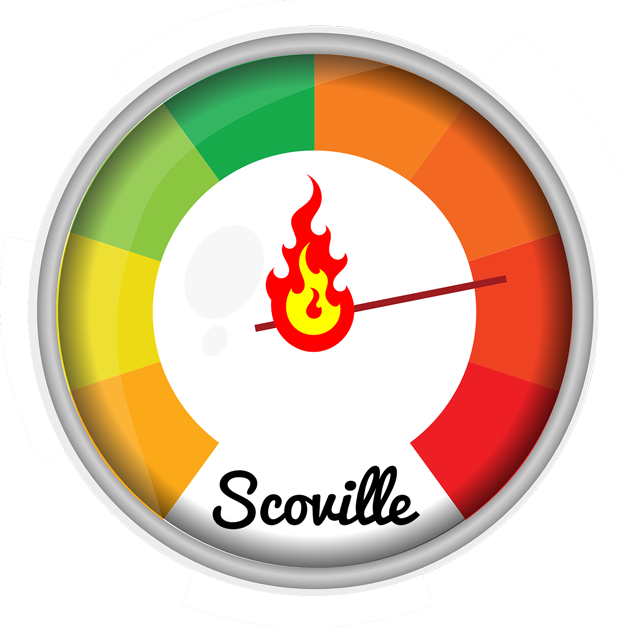Scoville Scale for Chili Pepper and Hot Sauce

THE ORIGINAL SCOVILLE SCALE
Welcome to the Original Scoville Scale. Here you can find everything about Scoville and of course the largest Scoville Scale for Chili Peppers and Hot Sauce available in the World Wide Web. Our goal is to list all Chili Peppers and Hot Sauces with their degree of pugency and their scoville value. Depending on the type and variety, chili peppers differ considerably in their pungency.
So there are species with no pungency such as bell peppers, varieties with a slight pungency such as Jalapeños, but also very hot chili peppers such as Habanero, Bhut Jolokia (Ghost Pepper) or Carolina Reaper. These super hot varieties are all varieties of the species Capsicum chinense. Varieties of the genus Capsicum chinense like Trinidad Moruga Scorpion or HP22B (Carolina Reaper) are one of the hottest chili cultivars in the world with a pungency of up to more than 2 million Scoville Heat Units. Pepper X has surpassed these, holding the current world record with an extraordinary 2.693 million SHU.
What is the Scoville Scale?
The Scoville scale is a measurement of the heat level in peppers, named after Wilbur Scoville, who developed the test in 1912. The scale ranges from 0 to 16 million Scoville Heat Units (SHU), with 0 being no heat and 16 million being the maximum heat level.
The Scoville scale is determined by measuring the amount of capsaicin in a pepper, which is the compound responsible for the heat. The higher the capsaicin concentration, the higher the Scoville rating.
While the Scoville scale is a useful tool for measuring heat, it’s important to remember that individual tolerance to heat can vary widely. Some people may find a jalapeño pepper too hot, while others can handle a ghost pepper with ease. It’s also important to handle hot peppers with care, as capsaicin can cause skin irritation and eye irritation if it comes into contact with these areas.
Our Scoville Heatmeter is a helpful guide for understanding the heat levels in peppers and hot sauces. So, the next time you’re trying a new pepper or a new hot sauce, take a look at the Scoville rating and prepare your taste buds accordingly!
The Scoville Scale and its History
In 1912, Wilbur Scoville, an American pharmacist, created the Scoville scale to measure the spiciness of peppers. He used a subjective method in which he tasted diluted pepper extracts and determined the dilution level at which he no longer felt any heat. The higher the dilution level required, the lower the SHU rating.
This method, however, had several limitations. It relied on individual taste perception and was prone to errors due to subjectivity. In addition, it was time-consuming and required a significant amount of pepper samples.
In the 1980s, a new method for measuring SHUs was developed using High-Performance Liquid Chromatography (HPLC). This method was more precise, accurate, and objective compared to the previous method. It also required smaller samples and provided a more reliable way of measuring the spiciness of peppers.
Measuring Scoville Heat Units (SHUs) with HPLC
For many people, the spiciness of food is a source of pleasure and enjoyment. However, for some, it can be a painful and uncomfortable experience. The Scoville scale is used to measure the spiciness of food, and it is based on the concentration of capsaicinoids in a particular food item. High-Performance Liquid Chromatography (HPLC) is one of the most commonly used methods to measure capsaicinoid concentration and calculate Scoville heat units (SHUs).
Measuring SHUs with HPLC
Capsaicinoids are the compounds that give peppers their spiciness. HPLC is a technique that can separate and quantify individual components of a sample. It works by passing a liquid sample through a stationary phase that separates the individual components based on their chemical properties. The separated components are then detected and quantified by a detector.
To measure capsaicinoid concentration using HPLC, a sample of the pepper is first extracted with a solvent, typically acetonitrile. The extract is then injected into the HPLC column, where the capsaicinoids are separated based on their chemical properties. A UV detector is used to detect and quantify the capsaicinoids.
The amount of capsaicinoids in the sample is then calculated based on the area under the curve of the capsaicinoid peak. This value is then converted into Scoville heat units using a conversion factor.
The Future of Measuring SHUs
While HPLC is currently the most widely used method for measuring SHUs, other techniques are being developed that could potentially provide even more precise and accurate results. For example, liquid chromatography-mass spectrometry (LC-MS) is a method that combines chromatography with mass spectrometry, providing more detailed information about individual capsaicinoids.
The Scoville scale is a useful tool for measuring the spiciness of food. While the subjective tasting method developed by Wilbur Scoville was a significant achievement in its time, HPLC has now become the standard method for measuring SHUs due to its objective and precise results. As new techniques continue to emerge, the future of measuring SHUs looks promising, and we may soon have even more accurate ways to measure the spiciness of our favorite foods.
